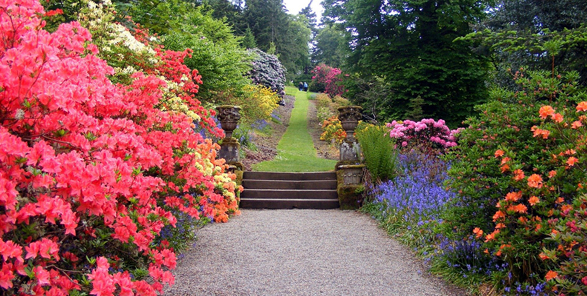
Early spring is a great time to turn a hum-drum landscape into the masterpiece of your dreams. Often, adding a few well-chosen and well-placed shrubs to the existing plant palette can make all the difference in the world.
Including shrubs in the landscape doesn’t just add beauty; shrubs give some unexpected benefits as well. Shrubs promote a healthy environment. They help enhance air quality by filtering out pollutants and adding oxygen. In areas prone to run-off or erosion, their deep roots can anchor soil and improve its stability.

Shrubs provide food, shelter and protection for wildlife. Berries are an important food source for a variety of birds and other animals. Nectar-rich blooms feed bees, butterflies, moths, and a variety of other insects. Nests are built in shrubs and burrows are dug underneath, housing many types of wildlife and giving quick get-away places to escape from predators.

Planted in appropriate locations, deciduous shrubs can help reduce energy costs by providing shade during their growing season and inviting warming sunshine into homes when they drop their leaves.
Groupings of shrubs can form a backdrop, letting shorter annuals, perennials and groundcovers bweecome stars of the garden show. On the other hand, from a utilitarian point of view, masses of shrubs can be used to create walls, suggesting a room, forming barriers that give much needed privacy or becoming screens to block an unsightly view.

Understanding the multitude of benefits shrubs add to the landscape, the staff at Embassy Landscape Group has some suggestions for you. While they definitely provide the typical benefits of shrubs, these five shrubs all have an added bonus. They all add outstanding interest to the winter landscape.
DOUBLEFILE VIBURNUM
Viburnum plicatum f. tomentosum



An easy to grow, upright multi-stemmed deciduous shrub frequently reaching 12 to 15 feet at maturity. Prefers well-drained soil in a full sun to part shade location. Viburnum needs consistent moisture levels to thrive, but once established, will tolerate occasional drought. Gorgeous . white blooms appear in April to May that attract bees and butterflies. Fall color is excellent and winter features bright red berries that birds flock to. Viburnum can be used alone as a single specimen plant or in groupings as a hedge or border. Rarely bothered by either insects or diseases, they are hardy in Zones 5 to 8.
OAK LEAF HYDRANGEA
Hydrangea quercifolia



Native to the bluffs and moist woodlands of the southeast, this deciduous shrub is another easy to grow specimen. Oak leaf hydrangea does best in rich, moist soils that drain well. Full sun to part shade locations ensures the best growth as does protection from harsh winters and hot, drying winds. Mature plants range in height from 6 to 8 feet. They are multi-stemmed and can sucker. Oak leaf hydrangeas are known for their long-lasting pyramidal shaped white blooms which begin in May and continue into July. The blooms, which are wonderful as cut flowers and are great for drying, often remain throughout the winter months, giving a beautiful winter display. Oak Leaf hydrangeas are lovely additions to foundation plantings, patio plantings and informal borders. While some varieties are prone to powdery mildew, most are insect and disease free. Hardy in zones 5 to 9.
OZARK WITCH HAZEL
Hamamelis vernalis



A Missouri native, Ozark witch hazel celebrates spring in the dead of winter. Beginning in January and often lingering through March or April (depending on the weather), this easy to grow deciduous shrub offers up unusually shaped, highly fragrant orange blooms that gradually turn to yellow. Blooms appear slightly before the emergence of the foliage. Ozark witch hazel prefers a full sun location in consistently moist, organically rich and well-drained soil. At maturity, it can reach 10 feet in height, but a height of 6 feet is more common. In the right conditions, this variety of witch hazel will quickly spread by suckers, so they may require periodic removal to keep the plant in check. It works well as a hedge or in a mixed border, but be sure to plant one where you can enjoy the fragrance and the winter color. Witch hazel is not bothered by insects, diseases or deer. Hardy in zones 4 to 8.
RED CHOKEBERRY
Aronia arbutifolia



Another native deciduous shrub that deserves a spot in today’s landscape, red chokeberry is a year- round star of the show! Extremely easy to grow, chokeberry flourishes in a wide variety of conditions. While it prefers full sun, chokeberry does well in partial shade. It loves wet, boggy conditions and unlike most shrubs, can thrive in either wet, clay or dry, sandy soils. Chokeberry has a vase-shaped growth pattern and can reach as high as 10 feet at maturity, although 6 to 8 is more common. It sports glossy green foliage in the summer, which then turns blood red in the fall. Clusters of white or pink flowers appear in April, followed by tight groups of vivid red berries along the branches. The edible fruit ripens in late summer, clinging to the branches throughout autumn and well into the winter months. Chokeberry makes a striking border plant and is perfect for rain gardens or at the edges of ponds or streams. Like most natives, chokeberry isn’t bothered by insects or diseases. Hardy in zones 4 to 9.
GOLDEN MOP CYPRESS
Chamaecyparis pisifera

For a touch of golden yellow foliage all year long, add Golden Mop cypress to your landscape. This cheery little evergreen is another easy to grow choice. Grown in a somewhat protected, partially shaded location, this extremely slow growing cypress will reach 3 feet in ten years and only 5 feet at full maturity. Golden Mop cypress does not like to have wet feet, so well-drained, fertile soils are best. With its soft, airy foliage, it makes a wonderful specimen plant and fits well into rock gardens. Hardy in zones 5 – 7.
